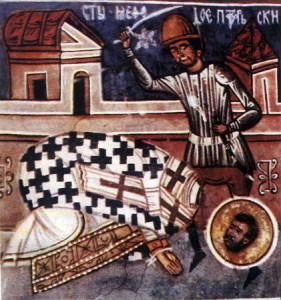 Methodius or Eubulius lived from 260-312 A.D. and served as bishop of both Olympus and Patara in Lycia. Jerome records that he was transferred to the See of Tyre in Phoenicia. He suffered martyrdom at Chalcis in Greece or possibly in Syria. Methodius is best known as a critic of Origen and his allegorical method of interpreting Scripture.[1] Epiphanius made considerable use of Methodius in his own refutation of Origen.[2]
Methodius or Eubulius lived from 260-312 A.D. and served as bishop of both Olympus and Patara in Lycia. Jerome records that he was transferred to the See of Tyre in Phoenicia. He suffered martyrdom at Chalcis in Greece or possibly in Syria. Methodius is best known as a critic of Origen and his allegorical method of interpreting Scripture.[1] Epiphanius made considerable use of Methodius in his own refutation of Origen.[2]
THE FEAST OF TABERNACLES
Methodius developed the sexta-septamillennial construct further by dovetailing it in with the Feast of Tabernacles:
For since in in six days God made the heaven and the earth, and finished the whole world, and rested on the seventh day from all His works which He had made, and blessed the seventh day and sanctified it, so by a figure in the seventh month, when the fruits of the earth have been gathered in, we are commanded to keep the feast to the Lord, which signifies that, when this world shall be terminated at the seventh thousand years…in the seventh month, the great resurrection-day, it is commanded that the Feast of our Tabernacles shall be celebrated to the Lord, of which the things said in Leviticus are symbols and figures…[3]
The Feast of Tabernacles or Sukkot is observed on the 15th through the 21st of Tishri, which is the seventh month of the ecclesiastical year in the Hebrew Calendar. To Methodius, the sexta-septamillennial construct did not just have implications for days and millenniums but also for at least one month. The final of the seven feasts of Israel on the seventh month indicated that it was a shadow of what is yet to be found in the seventh day or the Millennium. Leviticus 23 records all of the feasts or the appointed times of the LORD that Moses was to proclaim to the people of Israel. Methodius understood that these feasts were figures that pointed to greater realities.
Though Methodius does not list how each feast is fulfilled, he specifically identifies Passover as the spilling of Jesus’ blood on the cross[4] and Tabernacles as the Millennium:
For I also, taking my journey, and going forth from the Egypt of this life, came first to the resurrection, which is the true Feast of the Tabernacles, and there having set up my tabernacle, adorned with the fruits of virtue, on the first day of the resurrection, which is the day of judgment, celebrate with Christ the millennium of rest, which is called the seventh day, even the true Sabbath.[5]
The Millennium is not just the seventh day and the true Sabbath but also the true Feast of Tabernacles, beginning with the resurrection on the first day. The tabernacles are the bodies of the saints, which will once again be erected and inhabited.[6] Still on the first day, the bema or judgment seat of Christ will take place.[7]
Because Methodius’ view of the true meaning of this feast may be esoteric to some readers, a brief explanation is provided. The feasts of Israel were shadows of great wonders that Jesus would perform (Col. 2:16-17). The four spring feasts were all fulfilled by Jesus during His First Coming on the very day they were celebrated and in exact detail. The Messiah fulfilled Passover (Lev. 23:5) with His death on the cross (Rom. 3:25), Unleavened Bread (Lev. 23:6) with His burial (John 6:35-51), Firstfruits (Lev. 23:9-11) with His resurrection (1 Cor. 15:20) and Weeks or Pentecost (Lev. 23:15-16) the Holy Spirit being sent in Jesus’ name at Pentecost (Acts 2:2-4). We are left to speculate as to what will fulfill the remaining three fall feasts, though there is good evidence as to what each will be. The Feast of Trumpets (Lev. 23:23-25) is likely fulfilled by the resurrection and the gathering together of those in Christ (1 Cor. 15:51-52; 1 Th. 4:15-17). The Day of Atonement (Lev. 23:26-28) apparently foreshadows the Second Coming (Zech. 12:10; Matt. 24:30-31; Rev. 1:7). More on this is found here.
The Feast of Tabernacles being fulfilled by the Millennium follows both chronologically and scripturally. Jesus literally tabernacled with man as the divine Word housed in flesh (John 1:14).[8] He will tabernacle or live among men on the earth once again (Is. 24:21-23; Zech. 14:9; Rev. 20:4-6). On the first day of Tabernacles, branches of olive, wild olive, myrtle, palm and other leafy trees were gathered to make the tents (Lev. 23:40; Neh. 8:15). When Jesus manifested the glory of the LORD at His transfiguration, Peter responded by offering to erect tabernacles (Matt. 17:2-4). At the triumphal entry, some in the crowd cut down branches to spread on the road before Jesus (Matt. 21:8). In like manner, saints coming out of the great tribulation to enter the Millennium are described as holding palms in their hands (Rev. 7:9-14). When Jesus previewed the kingdom with his transfiguration, Peter offered to erect tents for him, Moses, and Elijah (Matt. 17:1-4). The apostle directly associated the Messianic Age with the Feast of Tabernacles.
Ezekiel foresaw the prince over Israel as having to oversee the Feast of Tabernacles in the Messianic age (Ezek. 45:25). Zechariah 14 prophesies the Second Coming (v. 4) and subsequent events that take place during the Millennium. Only one feast is mentioned as being celebrated: Tabernacles. During the Messianic age there will still be unbelievers on earth and they will be forced to celebrate the Feast of Tabernacles or King Jesus will not permit rain to fall on their land (vv. 17-18). The importance of observing the feast during this time among even the unsaved is striking, for it was given only to the people of Israel (Lev. 23:33-34 42-43). Tabernacles was to be followed by a separate but related celebration: the eighth day (Lev. 23:36). The ante-Nicene fathers who identified the eighth day, following the seventh day millennium, as the Eternal State may have found support in this post Tabernacles observance. The relationship between the Feast of Tabernacles and the future earthly reign of Jesus is remarkable.
Methodius continues with what follows the millennial feast:
Then again from thence I, a follower of Jesus, “who hath entered into the heavens,” as they also, after the rest of the Feast of Tabernacles, come into the heavens, not continuing to remain in tabernacles—that is, my body after the space of a thousand years, changed from a human and corruptible form into angelic size and beauty, where at last we virgins, when the festival of the resurrection is consummated, shall pass from the wonderful place of the tabernacle to greater and better things, ascending into the very house of God above the heavens…[9]
As a disciple of Jesus, Methodius sees himself as entering Heaven with a new angelic body after the thousand year feast of tabernacles. In this respect he takes after Tertullian in teaching that Matthew 22:30 and Luke 20:36 occur after the Millennium and that the Eternal State will be in Heaven instead of on a new earth.
[1] Alexander Roberts, James Donaldson and Arthur Cleveland Coxe, eds., the Ante-Nicene Fathers Volume VI – Fathers of the Third Century, 307.
[2] Ibid.
[3] Ibid., 344. Methodius, the Banquet of the Ten Virgins, dis. IX, ch. I.
[4] Ibid., 345. Methodius, the Banquet of the Ten Virgins, dis. IX, ch. I.
[5] Ibid., 347. Methodius, the Banquet of the Ten Virgins, dis. IX, ch. V.
[6] Ibid., 345. Methodius, the Banquet of the Ten Virgins, dis. IX, ch. III.
[7] Ibid., 346. Methodius, the Banquet of the Ten Virgins, dis. IX, ch. III.
[8] The Greek σκηνόω is commonly translated as dwelt in John 1:14. It literally means to abide in a tabernacle.
[9] Ibid., 347. Methodius, the Banquet of the Ten Virgins, dis. IX, ch. V.

[…] http://appleeye.org/2015/01/17/the-premillennialism-of-methodius/ […]